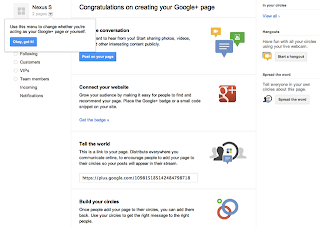Now Google+ Pages are officially launching, and it’s good news all around.
The first thing Horowitz did was to rattle off some stats: the service launched a little over 100 days ago, now has 40 million users and 3.4 billion photos uploaded, and has launched over one hundred new features. Not a bad start. Onto the Pages.
Google+ is taking another major step needed toward becoming a full-fledged Facebook rival: it’s launching Google+ Pages, which allow brands, products, companies, businesses, places, groups, and everyone else to establish a presence on the service. The product is a lot like Facebook Pages, but there’s one major difference: Google is baking some elements of Google+ Pages deep into its bread-and-butter search product.
It’s been a rocky road getting here. As you may recall, when Google+ first launched, Google asked brands and publishers not to create pages for their own sites, promising that there would be an official solution coming shortly. Not everyone heeded Google’s request (and, in hindsight, TechCrunch shouldn’t have either), but rather than apply its own rules, Google started making exceptions. A lot of people got upset, a new TechCrunch employee was spawned (and unceremoniously banned), and Google SVP Vic Gundotra later went on to say that the ordeal “was probably a mistake“.
Today, we find out why: when a user goes to Google and types in ‘+TechCrunch’, they’re asked if they’d like to add TechCrunch to one of their Google+ circles. If they say yes, then this behavior becomes automatic: I could type in +Harry Potter + Android and immediately start following the Pages for both of those pages, assuming they existed. Of course, this behavior isn’t exactly natural. But Horowitz points out that brands could start advertising it — it’s not hard to imagine a trailer closing with ‘+MovieTitle’, the same way they do with the ‘Like us on Facebook’ badges.
Google is describing this feature as Direct Connect to the brands it’s working with. If you want to set it up, you need to create your Google+ Page, then add a snippet of code to the associated official website of your brand (or publisher, or whatever). Once Google’s crawlers ‘see’ this code, which may take a while, the connection will be verified and users will be able to use the ‘+’ feature in Google search.
Update: Apparently only some users can create Google Pages for the time being — you can see if your account is enabled right here.
Post by http://techcrunch.com
skip to main |
skip to sidebar
Top Latest Technology News on this Tech News blog,News and reviews, with pictures, of games, gadgets, and technology
Wednesday, November 9, 2011
Subscribe to:
Post Comments (Atom)
Popular Tech News
-
Laptops are used in every household. Good laptops are available from 500$. Expensive laptops are also available with prices up to million do...
-
Jessica Simpson confirmed her much-speculated about pregnancy news via Twitter Monday.The news hardly comes as a surprise. Simpson, who ha...
-
There have been a number of rumors circulating around Yahoo, Microsoft, and Aol of late, most of them focusing on a potential Aol/ Yahoo...
-
Microsoft's YouTube channel appears to have been hacked and defaced. Microsoft's YouTube channel appears to have been hacked by som...
-
The new version of Facebook for Apple's popular iPad tablet has been rumored on industry blogs for months. Facebook said the iPad app w...
-
HP and Apple appear to be on opposing vectors -- both tied to leadership changes. It does look like Meg Whitman is starting smart, but she ...
-
Lady Gaga continues her reign as queen of Twitter by breaking yet another record on the micro-blogging site, notching 15 million followers. ...
-
At the very first time. You need to Skype pro acount to make calls in the cell in the United States and Canada, and fixed for free. Skype t...
-
About google new lanched music store .Google Music stores all of your music online so that you can save space on your computers and mobile d...
-
Apple , after facing a rash of complaints on the new phone's short battery life, had promised earlier to release an update to address th...











0 comments:
Post a Comment